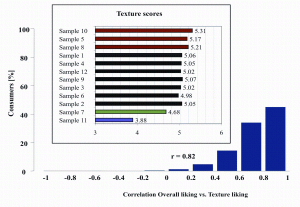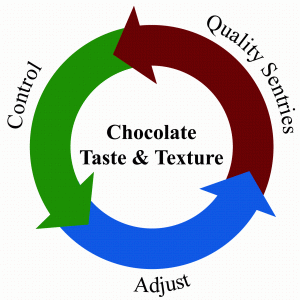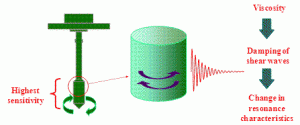Quality sentries: Some trends in chocolate manufacturing
- Like
- Digg
- Del
- Tumblr
- VKontakte
- Buffer
- Love This
- Odnoklassniki
- Meneame
- Blogger
- Amazon
- Yahoo Mail
- Gmail
- AOL
- Newsvine
- HackerNews
- Evernote
- MySpace
- Mail.ru
- Viadeo
- Line
- Comments
- Yummly
- SMS
- Viber
- Telegram
- Subscribe
- Skype
- Facebook Messenger
- Kakao
- LiveJournal
- Yammer
- Edgar
- Fintel
- Mix
- Instapaper
- Copy Link
Posted: 11 January 2013 | Ramana Sundara, John Rasburn and Josélio Vieira, Nestlé Product Technology Centre | No comments yet
In-line control elements are an increasing development in the pursuit of efficient processes in a wide range of manufacturing sectors. Advances in sensor technology and computing power are now providing instruments which can greatly improve the efficiency and accuracy of manufacturing, and at a cost which is moderate in comparison with other costs, such as raw material prices and fuel costs. In the food sector, there are two clear incentives for pursuing in-line monitoring capabilities. Firstly, they raise the quality of the foods produced and secondly, they reduce the waste of valuable raw materials. Increasing commodity prices in regard to food ingredients give particular importance to this aspect.
Confectionery manufacture is a case in point. In chocolate confectionery, the quality of the product is paramount for ensuring an enjoyable eating experience for the consumer. Consumer preference tests are used to determine to what extent the target consumers like each sample and why (Figure 1). Careful processing and selection of ingredients are therefore necessary to produce desirable sensory attributes1 (Figure 1).
In-line control elements are an increasing development in the pursuit of efficient processes in a wide range of manufacturing sectors. Advances in sensor technology and computing power are now providing instruments which can greatly improve the efficiency and accuracy of manufacturing, and at a cost which is moderate in comparison with other costs, such as raw material prices and fuel costs. In the food sector, there are two clear incentives for pursuing in-line monitoring capabilities. Firstly, they raise the quality of the foods produced and secondly, they reduce the waste of valuable raw materials. Increasing commodity prices in regard to food ingredients give particular importance to this aspect. Confectionery manufacture is a case in point. In chocolate confectionery, the quality of the product is paramount for ensuring an enjoyable eating experience for the consumer. Consumer preference tests are used to determine to what extent the target consumers like each sample and why (Figure 1). Careful processing and selection of ingredients are therefore necessary to produce desirable sensory attributes1 (Figure 1).
In-line control elements are an increasing development in the pursuit of efficient processes in a wide range of manufacturing sectors. Advances in sensor technology and computing power are now providing instruments which can greatly improve the efficiency and accuracy of manufacturing, and at a cost which is moderate in comparison with other costs, such as raw material prices and fuel costs. In the food sector, there are two clear incentives for pursuing in-line monitoring capabilities. Firstly, they raise the quality of the foods produced and secondly, they reduce the waste of valuable raw materials. Increasing commodity prices in regard to food ingredients give particular importance to this aspect.
Confectionery manufacture is a case in point. In chocolate confectionery, the quality of the product is paramount for ensuring an enjoyable eating experience for the consumer. Consumer preference tests are used to determine to what extent the target consumers like each sample and why (Figure 1). Careful processing and selection of ingredients are therefore necessary to produce desirable sensory attributes1 (Figure 1).
This requires keen attention to the flavour characteristics of the chocolate, which derive mainly from the primary and secondary processing of the cocoa ingredients. Careful control of the physical processing is also crucial for achieving the satisfying snap of a good chocolate and the smoothness in the palate. From particle sizes to polymorphism and rheology to aroma, the chocolate manufacturer engages numerous facets of food technology in seeking to deliver a quality product to their discerning customers.
From an economic viewpoint, the ingredi – ents derived from cocoa beans, namely cocoa butter, cocoa liquor and cocoa powder, are high-value components, and hence minimising waste is important. This applies also to the other raw materials used, namely sugar, milk powders (if present), emulsifiers, heat and power, and last but not least, water. Clearly, the incentive to produce ‘right first time’ is a keen one. Added to this is the on-going market pressure of delivering high quality at increasingly competitive prices.
In-line monitoring
The main quantities which can be targeted for in-line monitoring during chocolate manufacture can be classed into three categories: (a) visual characteristics (b) aroma characteristics and (c) material characteristics (Figure 2).
Appearance
Visual characteristics include colour and gloss. Measurement of these has been available for many years, but the increasing power and ubiquity of digital quantification now provides a capability for inferring changes which are very subtle indeed. Commercial systems have been developed for continuous colour measurement using a convenient installation (Hunter Associates Laboratory Inc, Reston, VA). This is particularly useful in regard to colour, since colour is often related to flavour characteristics, an important consideration when aiming for consistent flavour quality.
Colour measurement can be considered part of the more-general field of spectrometric measurement using illumination from other parts of the electromagnetic spectrum. Near infra-red, for instance, is now well-established in manufacturing2. Often this is for moisture measurement based on a validation exercise involving an independent moisture measure – ment for the product concerned. Confectionery wafers are an example of such an application. Interesting applications in the future are likely to include crystallisation measurement3 and protein quality. Other regions of interest include the microwave region for moisture measure – ment, X-rays for foreign-body detection, and the emerging terahertz band, a newly accessible region of the electromagnetic spectrum and which has pronounced sensitivity to small amounts of water.
Aroma
Evaluation of aroma characteristics using an inline instrument is an area of interesting advances. Although headspace analysis (the analysis of the aroma in the space above a food product in a container) is a well-developed technique in the laboratory chromatography system, the delicacy, complexity and expense of such instruments rules out their use in a production environment. Electronic noses for volatile detection are now being developed for food applications4,5, although the discrimina – tion and versatility can sometimes be difficult aspects. An interesting development in this field has arisen from advances in microchip technology, opening up the way for compact devices which can distinguish between aromas (and by association, flavours) to a sufficient extent to be useful. One such example is the FAIMS technique, Field Asymmetric Ion Mobility Spectrometry. This uses a microchip to apply alternating electric fields to ionised aroma molecules which are sampled continuously from the aromas and vapours above a processing stream. The electric fields sweep through a range of amplitudes so as to select different families of molecules, e.g. aldehydes or heterocyclics, based on their intrinsic diffusion characteristics within the air stream which carries them through the microchip. Each family responds in a different way to the electric field settings. An example of the FAIMS technique is the Lonestar instrument manufactured by Owlstone (Figure 3). The output can be displayed as a contour plot of ion current as function of the two independent electric field values (here termed compensation voltage on the x-axis, and differential field on the y-axis). Calibration, if preferred, requires a separate measurement using chemical standards. Potentially, in future one could envisage determining aroma intensities and composition. Alternatively, if the optimum field settings are identified for the particular flavour compound of interest, a control system can be implemented based on an alarm which is triggered when the intensity drops below or exceeds a user-defined interval (Figure 3).
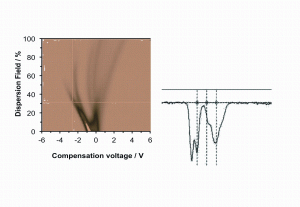

Figure 3: Data from an experiment on an Owlstone Lonestar FAIMS analyser for measuring aroma intensity and composition. The sample involved was a commercial milk chocolate at 50°C. The figure on the left shows the distinctive contour plot of ion current as a function of the selecting electric fields, the dispersion field and the compensation voltage. The compensation voltage was swept between -6 volts and +6 volts for a series of increments of the dispersion field, which ranged from 40 per cent to 100 per cent. This disperses the ionised aroma into families of ions according to mobility, and results in a flame-like pattern. The figure on the left shows a slice through the contour plot, taken at a dispersion field value of 60 per cent. Negative ion mode was selected for the data shown, and hence the ion current (in arbitrary units) is negative
Material characteristics
Material characteristics encompass several aspects, most notably the particle size of the sucrose crystals, the rheology of the chocolate mass when molten and the crystalline form of the cocoa butter of the chocolate when finished. Traditionally, all three are measured off-line, a circumstance which hampers fine control of the process.
(a) Crystalline forms: An additional compli – cation in the case of cocoa butter is its inherent polymorphism. Good quality chocolate products require the cocoa butter to be in the Form V (melting point 33°C), one of the two most stable polymorphs of cocoa butter. This polymorphic form delivers the characteristic snap and cooling effects which are part of the satisfying eating experience from chocolate.
(b) Flow properties: The possible application of in-line viscosity measurements as a tool for process and quality control has provoked considerable interest in food manufacture. The need for robust, hygienic, real-time, measurements to provide meaning ful process information is now widely acknowledged and has come under considerably scrutiny within the industry.
The flow properties of chocolate are critical to many aspects of its performance, particularly during production. The industry accepted method of measuring viscosity is the procedure by the International Office of Cocoa6. It employs a rotational viscometer fitted with a concentric cylinder to measure the chocolate flow curve between 2 and 50 s-1 at 40°C. The viscosity of chocolate is conventionally expressed by two parameters, yield values and plastic viscosity. Yield value has been found to relate to both pattern holding and formation of feet and tails; plastic viscosity has been found important in controlling the filling processes and pumping. While such a method does ensure batch-tobatch consistency it provides little or no relationship to the viscosity of the chocolate once it is tempered. The viscosity of the tempered chocolate will be affected by the lower processing temperature (around 30°C) and the presence of fat crystals produced during tempering, increasing the dispersed phase volume fraction.
The advantages of an in-line viscometry that provides continuous real-time viscosity measurement include:
- The ability to monitor the process, gaining a better understanding of the production system and ultimately improving the process control
- Better understanding of the process inevitably leading to more informed changes and enhancements to the prod – uction process
- Adjusting the viscosity by the controlled addition of fat and/or emulsifier.
Commercial solutions for in-line viscosity measurement of chocolate are very limited. They include the Hydramotion process visco – meter, which is designed to be mounted directly into holding tanks or process piping. The mechanism utilised to measure viscosity is the frequency shift of a resonant frequency (Figure 4).
It provides a single point viscosity value, which has been found to correlate well with the Casson plastic viscosity measured off-line (Figure 5); it does not however provide any information about yield stress.
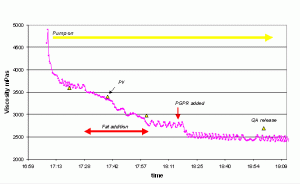

Figure 5: Viscosity of chocolate mass following addition of fat and emulsifier. In-line viscosity (pink curve) measured with in-line vibrational viscometer and plastic viscosity (yellow triangle) measured off-line with a rotational viscometer
Research studies on the development of in-line techniques that can potentially allow the full characterisation of flow properties of chocolate, including tempered chocolate, have been published elsewhere. Characterisa – tion of the flow behaviour of chocolate during processing in pipes or extrusion devices has been investigated using flow visualisation techniques such as MRI7 and ultrasound velocity profile8 combined with pressure drop. These visual isation techniques give excellent agreement with off-line results, however they require time consuming data processing and are still very cost prohibitive for a chocolate process control tool. The potential application of in-line tools for chocolate process control is large, but limita – tions exist as it requires careful selection of the measurement principle.
Conclusion
Sensory attributes of eating chocolate are determined by processing variables and inherent characteristics of the cocoa bean. Its sensory attributes, a characteristic flavour and a unique mouth-feel (attributable to a narrow melting range near body temperature) are appealing. Control of both the final texture and the flavour are vital, the latter being partly dictated by the initial roasting conditions and partly by subsequent processing in the manufacture of the finished product. The mouthfeel and textural properties are determined by the unique properties of cocoa butter. Careful processing and selection of ingredients is necessary to produce desirable attributes.
Today, it is becoming recognised that the most effective error-proofing programmes use in-line sensors to eliminate errors as an integral part of the manufacturing process itself. The productivity gains from the various software tools are impressive, but the results from error reduction are arguably even greater. Whether the production process is automatic or semiautomatic, using sensors to verify the manu – facturing steps that drive quality work is the best way to guarantee that the chocolate being produced meets customer preferences.
References
1. Hoskin, J.C. 1994; Am. J Clinical Nutrition, 60: 1068-1070.
2. Patel, P.D., and C.Beveridge, in Rapid and on-line instrumentation for food quality assurance, ed. I.E.Tothill, Woodhead Publishing (2003)
3. Bolliger, S., Y.Zeng and E.J.Windhab (1999), “In-line Measurement of Tempered Cocoa Butter and Chocolate by Means of Near-Infrared Spectroscopy.” J.Am.Oil Chem.Soc, 76, 659 -67.
4. Persaud, K.C., and P.J.Travers, in Handbook of Biosensors and Electronic Noses : Medicine, Food, and the Environment, ed. E.Kress-Rogers, CRC Press (1997)
5. Zhang, H., in Rapid and on-line instrumentation for food quality assurance, ed. I.E.Tothill, Woodhead Publishing (2003)
6. International Office of Cocoa, “Viscosity of Cocoa and Chocolate Products,” Analytical Method 46 (2000). Available from CAOBISCO, rue Defacqz 1, B- 1000 Bruxelles, Belgium.
7. Wichchukit, S.; McCarthy, M. J.; MCCarthy, K. L. Journal of Food Science, (2005) 70, E165-E171.
8. Ouriev. B, Windhab E., Braun P., Zang Y. and Birkhofer B. (2003) Review of Scientific Instruments 74 (12), 5255-59.
About the authors
John Rasburn is a research scientist at the Nestlé Product Technology Centre, York. His work is directed mainly at physical property measurement, particularly in regard to crystallisation. John joined PTC York in 2006 following 18 years in polymer research including his PhD at Leeds University, post-doctoral appointments and five years in polymer film manufacture.
Josélio Vieira is a Principal Research Scientist at the Nestlé Product Technology Centre for confectionery products in York, UK. Josélio is a Chemist by training and holds a PhD degree in Physical Chemistry from the University of Oxford. After graduating, he worked for 11 years at Dow AgroSciences in the development of crop protection formulations in the Formulation Science & Technology group in Brazil and the UK. He then joined Nestlé at the Product Technology Centre in Beauvais, France, dedicated to ice cream product technology development. After five years in France, Josélio was relocated to York where he now works in the Chocolate Department. His interests include Colloidal and Formulation sciences. Josélio has co-authored and published a number of research papers and patents on chocolate and ice cream technologies.
Dr. Ramana Sundara is a Fellow and Chartered Scientist of Institute of Food Science and Technology (UK). Currently, he is the Manager of External Research Collaborations at Nestlé Product Technology Centre, York, UK. He has published over 33 scientific papers / presentations and five patents, with an emphasis on fruits, vegetables, chocolate, dairy chemistry and processing technology.



